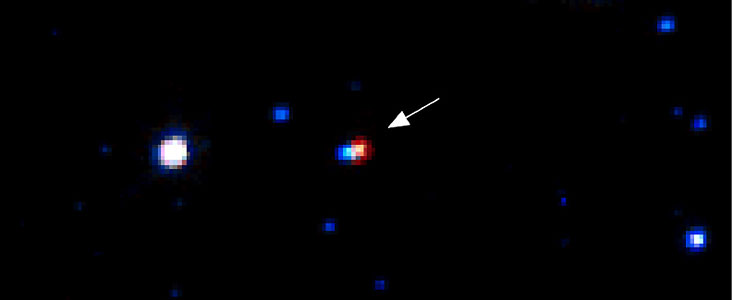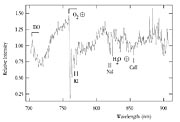Pressemitteilung
First Image and Spectrum of a Dark Matter Object
HST and VLT Identify MACHO as a Small and Cool Star
5. Dezember 2001
An international team of astronomers [2] has observed a Dark Matter object directly for the first time. Images and spectra of a MACHO microlens - a nearby dwarf star that gravitationally focuses light from a star in another galaxy - were taken by the NASA/ESA Hubble Space Telescope (HST) and the European Southern Observatory's Very Large Telescope (VLT). The result is a strong confirmation of the theory that a large fraction of Dark Matter exists as small, faint stars in galaxies such as our Milky Way.
The Riddle of Dark Matter
The nature of Dark Matter is one of the fundamental puzzles in astrophysics today. Observations of clusters of galaxies and the large scale structure of individual galaxies tell us that no more than a quarter of the total amount of matter in the Universe consists of normal atoms and molecules that make up the familiar world around us. Of this normal matter, no more than a quarter emits the radiation we see from stars and hot gas. So, a large fraction of the matter in our Universe is dark and of unknown composition .
For the past ten years, active search projects have been underway for possible candidate objects for Dark Matter. One of many possibilities is that the Dark Matter consists of weakly interacting, massive sub-atomic sized particles known as WIMPs. Alternatively, Dark Matter may consist of massive compact objects (MACHOs), such as dead or dying stars (neutron stars and cool dwarf stars), black holes of various sizes or planet-sized collections of rocks and ice.
The MACHOs
In 1986, Bohdan Paczynski from Princeton University (USA) realised that if some of the Dark Matter were in the form of MACHOs, its presence could be detected by the gravitational influence MACHOs have on light from distant stars.
If a MACHO object in the Milky Way passes in front of a background star in a nearby galaxy, such as the Large Magellanic Cloud (LMC), then the gravitational field of the MACHO will bend the light from the distant star and focus it into our telescopes. The MACHO is acting as a gravitational lens, increasing the brightness of the background star for the short time it takes for the MACHO to pass by.
Depending on the mass of the MACHO and its distance from Earth, this period of brightening can last days, weeks or months. The form and duration of the brightening caused by the MACHO - the microlensing "light curve" - can be predicted by theory and searched for as a clear signal of the presence of MACHO Dark Matter.
MACHOs are described as "microlenses" since they are much smaller than other known cases of gravitational lensing, such as those observed around clusters of galaxies. Observations of microlensing events have been done on many occasions with ESO telescope with intersting results, e.g., the recent detection of a corona of a distant star in the Milky Way.
The MACHO Project
Astronomers from the Lawrence Livermore National Laboratory, the Center for Particle Astrophysics in the United States and the Australian National University joined forces to form the "MACHO Project" in 1991. This team [2] used a dedicated telescope at the Mount Stromlo Observatory in Australia to monitor the brightness of more than 10 million stars in the Large Magellanic Cloud (LMC) over a period of eight years.
The team discovered their first gravitational lensing event in 1993 and have now published approximately twenty instances of microlenses in the direction of the Magellanic Clouds. These results demonstrate that there is a population of MACHO objects in and around the Milky Way galaxy that could comprise as much as 50% of the Milky Way total (baryonic/normal-matter) Dark Matter content.
Hubble obtains the first direct image of a MACHO
In order to learn more about each microlensing event, the MACHO team has used the Hubble Space Telescope (HST) to take high-resolution images of the lensed stars.
One of these images showed a faint red object within a small fraction of an arcsecond from a blue, normal (main-sequence) background star in the Large Magellanic Cloud.
The image was taken by Hubble 6 years after the original microlensing event, which had lasted approximately 100 days. The brightness of the faint red star and its direction and separation from the star in the Large Magellanic Cloud are completely consistent with the values indicated 6 years earlier from the MACHO light curve data alone.
This Hubble observation further reveals that the MACHO is a small faint, dwarf star at a distance of 600 light-years, and with a mass between 5% and 10% of the mass of the Sun.
The VLT adds spectral information
To further confirm these findings, members of the MACHO team sent in a special application for observing time on the FORS2 instrument on the ESO 8.2-m VLT KUEYEN Unit Telescope to obtain spectra of the object. ESO responded swiftly and positively to the request. Although it was not possible to separate the spectra of the MACHO and background star, the combined spectrum (ESO Press Photo eso0140) showed the unmistakable signs in the red spectral region of the deep absorption lines of a dwarf M star superimposed on the spectrum of the blue main sequence star in the Large Magellanic Cloud.
The nature of Dark Matter
The combination of the microlensing light curve from the MACHO project, the high-resolution images from Hubble and the spectroscopy from the VLT has established the first direct detection of a MACHO object, to be published in the international science journal "Nature" on December 6, 2001.
Thanks to the HST and VLT observations, the astronomers now have a complete picture of this particular MACHO: its mass, distance and velocity. The result greatly strengthens the argument that a large fraction of the 'normal' Dark Matter in and around our galaxy exists in the form of MACHOs. Thus this Dark Matter is not as dark as previously believed!
Future searches for MACHO-like objects will have the potential to map out this form of Dark Matter and reach a greater understanding of the role that Dark Matter plays in the formation of galaxies. These efforts will further strengthen the drive to reveal the secrets of Dark Matter and take a large step towards closing the books on the mass budget of the Universe.
Endnoten
[1] This is a joint Press Release by the European Southern Observatory (ESO) and the Hubble European Space Agency Information Centre. The Hubble Space Telescope is a project of international co-operation between ESA and NASA.
[2] The MACHO collaboration is made up of: Kem H. Cook, Andrew J. Drake, Stefan C. Keller , Stuart L. Marshall, Cailin A. Nelson and Piotr Popowski (Lawrence Livermore National Laboratory, Livermore, CA, USA); Charles Alcock and Matt J. Lehner (University of Pennsylvania, Philadelphia, PA, USA); Robyn A. Allsman (Australian National Supercomputing Facility, Canberra, ACT, Australia); David R. Alves (STScI, Baltimore, USA); Tim S. Axelrod, Ken C. Freeman and Bruce A. Peterson (Mount Stromlo Observatory, Weston, ACT, Australia); Andrew C. Becker (Bell Labs, Murray Hill, NJ, USA); Dave P. Bennett (University of Notre Dame, IN, USA); Marla Geha (University of California at Santa Cruz, CA, USA); Kim Griest and Thor Vandehei (University of California, San Diego, CA, USA); Dante Minniti (P. Universidad Catolica, Santiago de Chile); Mark R. Pratt , Christopher W. Stubbs and Austin B. Tomaney (University of Washington, Seatlle, WA, USA); Peter J. Quinn (European Southern Observatory, Garching, Germany); Will Sutherland (University of Oxford, UK) and Doug Welch (McMaster University, Hamilton, Ontario, Canada).
Kontaktinformationen
Peter Quinn
ESO
Garching, Germany
Tel: +4989-3200-6509
E-Mail: pjq@eso.org
Cailin Nelson
Lawrence Livermore National Laboratory
USA
Tel: +1-925-423-2852
E-Mail: cnelson@igpp.ucllnl.org
Dante Minniti
P. Universidad Catolica - Depto de Astronomia
Chile
Tel: +56 2 686 4946
E-Mail: dante@astro.puc.cl
Tim Axelrod
Research School of Astronomy and Astrophysics - Australian National University
Australia
Tel: +61-2-6125-0214
E-Mail: tsa@mso.anu.edu.au
Lars Lindberg Christensen
Hubble European Space Agency Information Centre
Garching, Germany
Tel: +49-89-3200-6306
Mobil: +49-173-38-72-621
E-Mail: lars@eso.org
Richard West
ESO
Garching, Germany
Tel: +49-89-3200-6276
E-Mail: rwest@eso.org
Über die Pressemitteilung
| Pressemitteilung Nr.: | eso0140 |
| Legacy ID: | PR 28/01 |
| Name: | Gravitational Microlensing, Spectrum |
| Typ: | Milky Way : Cosmology : Phenomenon : Lensing Milky Way : Cosmology : Phenomenon : Dark Matter |
| Facility: | Hubble Space Telescope, Very Large Telescope |
| Instruments: | FORS2 |
| Science data: | 2001Natur.414..617A |


